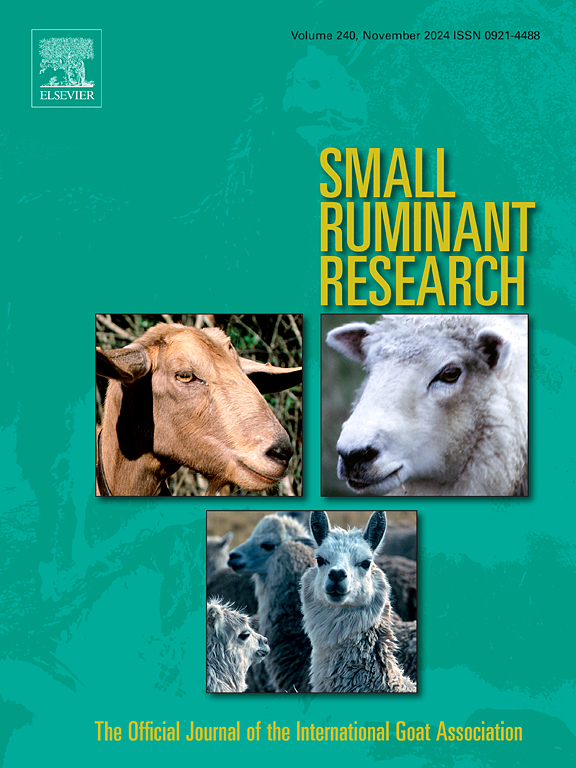Supplementation of orally drenched ascorbic acid and injectable α-tocopherol reduces markers of naturally acquired parasites in grazing hair sheep
IF 1.6
3区 农林科学
Q2 AGRICULTURE, DAIRY & ANIMAL SCIENCE
引用次数: 0
Abstract
The objective of this study was to evaluate the effects of exogenous vitamin E and C supplementation in grazing hair sheep on markers of naturally acquired parasites, hypothesizing that supplementing vitamins may be effective as anthelmintics in controlling parasites. Twenty-six lambs and thirty-one ewes were stratified by FAMACHA® scores and placed in one of five treatment groups: (1) control (CON; Lambs: n = 6, Ewes: n = 4), (2) dewormer (DW; Levamed; 0.08 mg/kg; Lambs: n = 5, Ewes: n = 7), (3) vitamin C (VC; Vitamin C;0.56 ml/kg of BW; Lambs: n = 5, Ewes: n = 6), (4) vitamin E (VE; Vitamin E 300; 22 IU/kg of BW; Lambs: n = 6, Ewes: n = 7), and (5) combination of vitamins E and C (E + C; same dosages as vitamins C and E; Lambs: n = 4, Ewes: n = 7). Physiological, parasitology and blood metabolite parameters samples were collected on day 0, 14, 28, 56, and 77. The following parameters and treatments are compared to the CON, unless otherwise mentioned. FAMACHA® scores improved in lambs treated with DW (P = 0.0001), E + C (P = 0.04), VC (P = 0.02), and VE (P = 0.01). Eggs per gram (EPG) decreased in lambs treated with DW (P = 0.001), VC (P = 0.001) and VE (P = 0.008). Alanine transaminase (ALT) decreased (P = 0.04) in lambs treated with DW and VE treated lambs increased (P = 0.02) in ALT compared to the dewormer. Packed cell volume (PCV) in the ewes improved with E + C (P = 0.02) and VE (P = 0.03) compared to DW. The data suggests that vitamin E and C supplementation can be used as a tool to assist in managing parasites in grazing hair sheep.
补充口服浸透抗坏血酸和注射α-生育酚可降低放牧毛羊体内自然获得性寄生虫标志物
本研究的目的是评价外源补充维生素E和C对放牧毛羊自然获得性寄生虫标志物的影响,并假设补充维生素可能作为驱虫药有效地控制寄生虫。按FAMACHA®评分对26只羔羊和31只母羊进行分层,分为5个处理组:(1)对照组(CON;羔羊:n = 6,母羊:n = 4),(2)驱虫剂(DW;Levamed; 0.08毫克/公斤;羔羊:n = 5,母羊:n = 7),(3)维生素C (VC;维生素C, 0.56 ml/kg BW;羔羊:n = 5,母羊:n = 6),(4)维生素E (VE;维生素E 300;22 IU/kg体重;羔羊:n = 6,母羊:n = 7),以及(5)维生素E和C的组合(E + C;与维生素C和E的剂量相同;羔羊:n = 4,母羊:n = 7)。在第0、14、28、56和77天采集生理、寄生虫学和血液代谢物参数。除非另有说明,以下参数和处理方法与CON进行比较。FAMACHA®分数提高羔羊对待DW (P = 0.0001),E + C (0.04 P = ),VC (P = 0.02),(0.01 P = )。DW (P = 0.001)、VC (P = 0.001)和VE (P = 0.008)处理的羔羊每克产蛋数(EPG)降低。与驱虫剂相比,DW组谷丙转氨酶(ALT)降低(P = 0.04),VE组谷丙转氨酶(ALT)升高(P = 0.02)。与DW相比,E + C (P = 0.02)和VE (P = 0.03)提高了母羊的堆积细胞体积(PCV)。这些数据表明,补充维生素E和C可以作为一种工具,帮助管理放牧毛羊的寄生虫。
本文章由计算机程序翻译,如有差异,请以英文原文为准。
求助全文
约1分钟内获得全文
求助全文
来源期刊

Small Ruminant Research
农林科学-奶制品与动物科学
CiteScore
3.10
自引率
11.10%
发文量
210
审稿时长
12.5 weeks
期刊介绍:
Small Ruminant Research publishes original, basic and applied research articles, technical notes, and review articles on research relating to goats, sheep, deer, the New World camelids llama, alpaca, vicuna and guanaco, and the Old World camels.
Topics covered include nutrition, physiology, anatomy, genetics, microbiology, ethology, product technology, socio-economics, management, sustainability and environment, veterinary medicine and husbandry engineering.
 求助内容:
求助内容: 应助结果提醒方式:
应助结果提醒方式:


